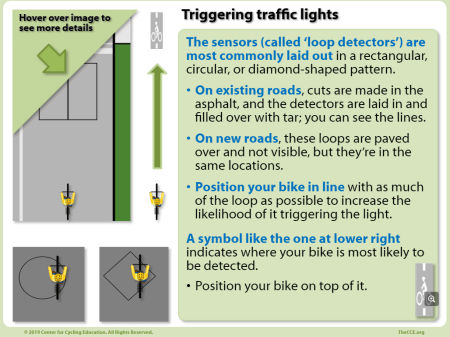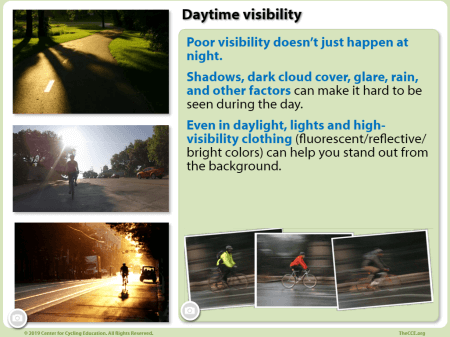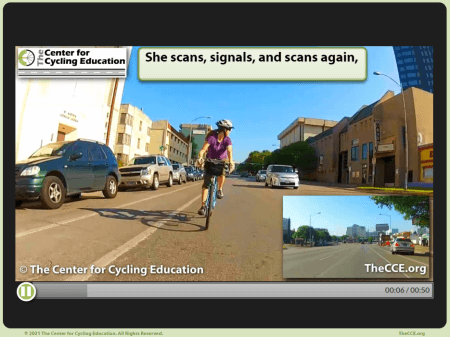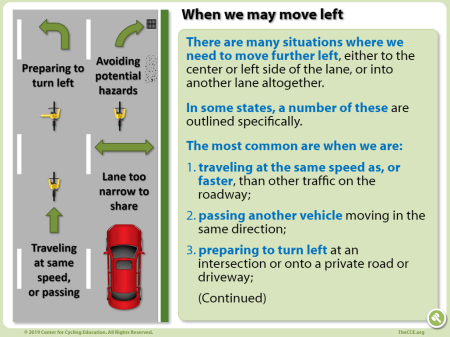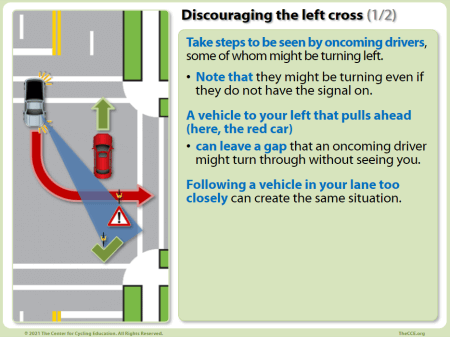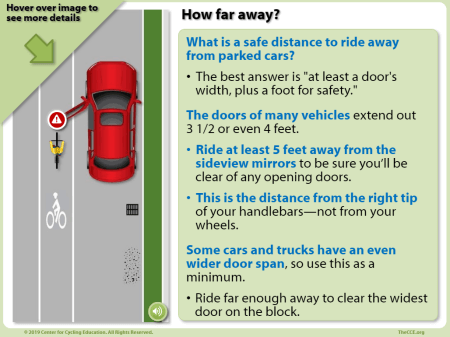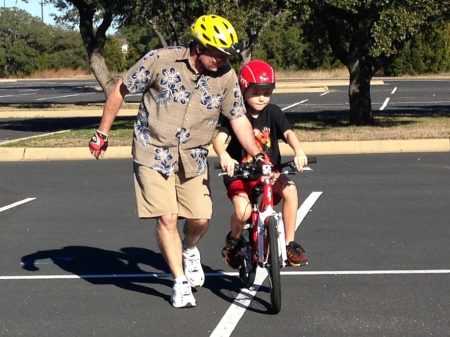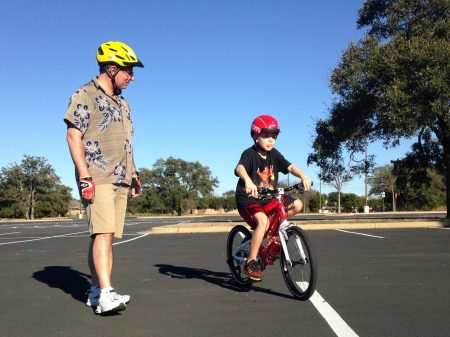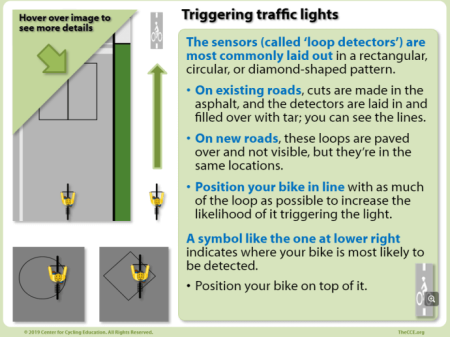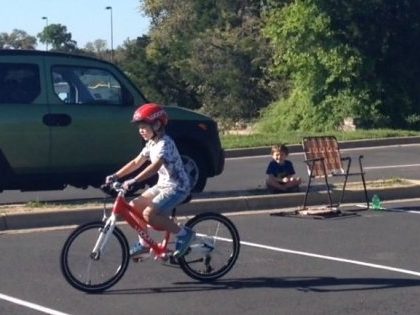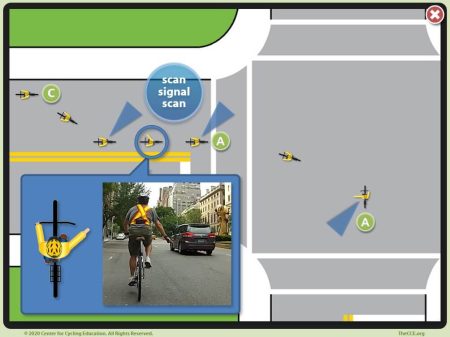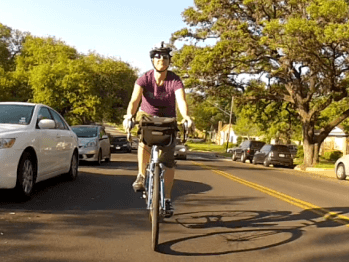Cycling Laws » Canada » SK – Saskatchewan » Saskatchewan Traffic Safety Act
See below for the provincial laws that apply to riding your bike in Saskatchewan.
In the Saskatchewan Traffic Safety Act, there is no separate section for cyclists.
• The only mention of bicycles is that of power-assisted bicycles.A bicycle is considered a vehicle.
• References to the responsibilities of drivers of ‘vehicles,’ apply to people riding a bicycle.There are elements of the law that apply only to drivers or owners of motor vehicles, including general operation, driver licensing requirements, and vehicle registration, among others.
When walking your bicycle you are considered to be a pedestrian, and are subject to the applicable rules of the road.
TRAFFIC REGULATIONS IN SASKATCHEWAN, SK
NOTE: These consolidations are not official. Amendments have been incorporated for convenience of reference and the original statutes and regulations should be consulted for all purposes of interpretation and application of the law. In order to preserve the integrity of the original statutes and regulations, errors that may have appeared are reproduced in this consolidation.
-
SASKATCHEWAN TRAFFIC SAFETY ACT – CHAPTER T-18.1 (‘TSA’)
An Act respecting Traffic Safety, Vehicles and Drivers, Owners and Operators of Vehicles and making consequential amendments to other Acts
Link to the full Act on the CanLII (Canadian Legal Information Institute) website. ![]()
-
THE VEHICLE EQUIPMENT REGULATIONS, 1987 (‘VER’)
Link to the full Regulations on the CanLII (Canadian Legal Information Institute) website. ![]()
TSA: Definitions
PART I: Short title and Interpretation
Short title
1 This Act may be cited as The Traffic Safety Act.
Interpretation
2(1) In this Act:
(b) “animal” does not include a horse with a rider or driver;
(j.1) “hamlet” means a hamlet or an organized hamlet as defined in The Municipalities Act;
(k) “highway” means a road, parkway, driveway, square or place designed and intended for or used by the general public for the passage of vehicles, but does not include any area, whether privately or publicly owned, that is primarily intended to be used for the parking of vehicles and the necessary passageways on that area;
(r) “motor vehicle” means a vehicle propelled or driven by any means other than by muscular power;
(t) “municipality” includes the City of Lloydminster;
(u) “official sign” means a sign, pavement marking, barricade or object that is authorized by the minister responsible for the administration of The Highways and Transportation Act, 1997 pursuant to another Act or by that minister or any other person pursuant to this Act to be erected, placed, used or painted on the roadway or right of way of a highway for the legal control, warning, guidance, direction or information of traffic on the highway;
(v) “one-way highway” means a highway designated as one-way by signs on or erected or posted along the highway directing traffic to proceed in only one direction;
(y) “parking” means the standing of a vehicle, whether occupied or not, on a highway, other than standing temporarily:
(i) for the purpose of and while actually engaged in loading or unloading; or
(ii) in obedience to traffic regulations, traffic control devices or the directions of a peace officer;
(z) “peace officer” means:
(i) a member of a police service in Saskatchewan;
(ii) a person or class of persons designated by the Lieutenant Governor in Council as traffic officers; or
(iii) any person appointed pursuant to The Police Act, 1990 as a special constable for the enforcement of this Act;
(aa) “pedestrian” includes a person in a wheelchair;
(aa.1) “power-assisted bicycle” means a prescribed vehicle; [See below.]
(dd) “prescribed” means prescribed by the Lieutenant Governor in Council in the regulations;
(ee) “province” means a province of Canada and includes the Yukon and Northwest Territories and Nunavut;
(qq) “stop” means:
(i) when required, a complete cessation from movement; and
(ii) when prohibited, any stopping, even momentarily, of a vehicle, whether occupied or not, except when necessary to avoid conflict with other traffic or in compliance with the directions of a peace officer or a traffic control device;
(ww) “traffic control device” means a sign, signal, marking or device that is placed, marked or erected for the purpose of regulating, warning or guiding traffic;
(xx) “traffic control signal” means a traffic control device, whether manually, electrically or mechanically operated, by which traffic is directed to stop and to proceed;
(yy) “traffic lane” means a longitudinal division of a highway of sufficient width to accommodate the passage of a single line of vehicles;
(zz) “trailer” means a vehicle, other than a semi?trailer, that is at any time drawn on a highway by a motor vehicle and that is designed for the conveyance of goods or as living quarters for persons, but does not include:
(i) a motor vehicle towed for sale, storage or repair purposes;
(ii) a farm implement;
(iii) an axle unit with a fifth wheel assembly used to convert a semi?trailer to a trailer;
(iv) a timber or metal beam with wheels attached used for the purpose of moving buildings;
(v) an asphalt distributor used for the construction or maintenance of bituminous surfaced highways;
(vi) Repealed. 2018, c 45, s.3.
(vii) a tow dolly;
(ccc) “vehicle” means a device in, on or by which a person or thing is or may be transported or drawn on a highway and includes special mobile machines and farm implements but does not include vehicles running only on rails or solely on railway company property;
Motor Vehicle Safety Regulations  (under the Motor Vehicle Safety Act
(under the Motor Vehicle Safety Act  )
)
— SOR/2020-22, s. 3
3 (1) [In force]
(2) The definitions power-assisted bicycle and restricted-use motorcycle in subsection 2(1) of the Regulations are repealed.
power-assisted bicycle means a vehicle that:
(a) has steering handlebars and is equipped with pedals,
(b) is designed to travel on not more than three wheels in contact with the ground,
(c) is capable of being propelled by muscular power,
(d) has one or more electric motors that have, singly or in combination, the following characteristics:
(i) it has a total continuous power output rating, measured at the shaft of each motor, of 500 W or less,
(ii) if it is engaged by the use of muscular power, power assistance immediately ceases when the muscular power ceases,
(iii) if it is engaged by the use of an accelerator controller, power assistance immediately ceases when the brakes are applied, and
(iv) it is incapable of providing further assistance when the bicycle attains a speed of 32 km/h on level ground,
(e) bears a label that is permanently affixed by the manufacturer and appears in a conspicuous location stating, in both official languages, that the vehicle is a power-assisted bicycle as defined in this subsection, and
(f) has one of the following safety features,
(i) an enabling mechanism to turn the electric motor on and off that is separate from the accelerator controller and fitted in such a manner that it is operable by the driver, or
(ii) a mechanism that prevents the motor from being engaged before the bicycle attains a speed of 3 km/h;?(bicyclette assistée)
TSA: PART XVI: Rules of the Road
PART XVI: Rules of the Road
(A bicycle is considered a vehicle. Following are the rules of the road referring to vehicles or operators of vehicles. References to motor vehicles and their operators have been omitted.)
DIVISION 2: Speed
Speeding prohibited
199
(3) No person shall drive a vehicle on a highway at a speed greater than is reasonable and safe in the circumstances.
(4) No person shall drive a vehicle on a highway at a speed that impedes the normal and reasonable movement of traffic on the highway except when necessary for the safe operation of the vehicle.
Speed restrictions in school zones
200
(1) In this section, “school zone” means the area between:
(a) the traffic control device or official sign identifying an area as a school zone; and
(b) the traffic control device or official sign indicating a greater rate of speed or the end of the area as a school zone.
(2) No person shall drive a vehicle in a school zone at a speed greater than the maximum speed indicated by any official sign.
(3) If required to do so in the regulations, a municipality shall enact a bylaw that complies with the regulations respecting:
(a) the maximum speed at which vehicles may be driven in a school zone; and
(b) the placing of traffic control devices and the posting of official signs to indicate school zones.
(4) No person shall fail to comply with a bylaw enacted in accordance with subsection (3).
(5) This Act and the regulations prevail in the case of any conflict between:
(a) this Act and the regulations; and
(b) a bylaw enacted in accordance with subsection (3).
Speeding in parks prohibited
202
(1) Notwithstanding any other provision of this Act, the authority having jurisdiction over a park:
(a) may fix the maximum speed of vehicles within the park; and
(b) if the authority acts pursuant to clause (a), shall indicate that maximum speed by placing signs at each entrance and throughout the park.
(2) No person shall drive a vehicle in the park in excess of the maximum speed indicated on the signs.
Speeding when passing animals prohibited
206
When approaching any animal visible on or beside a highway or so close to the highway as to constitute a hazard, no driver of a vehicle shall:
(a) fail to reduce the vehicle’s speed; or
(b) pass the animal unless it is safe to do so.
Rules re stopping
209
(6) No driver of a vehicle shall fail to bring the vehicle to a stop:
(a) at every place where a stop sign is erected;
(b) when approaching a railway crossing, and a signal person or automatic signal indicates the approach of a train; or
(c) when directed to do so by a school crossing guard patrolling a crosswalk pursuant to subsection 190(6) of The Education Act, 1995.
(6.1) If a driver is required by this Act to bring a vehicle to a stop at a stop sign, the driver shall bring the vehicle to a stop:
(a) on the near side of the intersection at the marked stop line;
(b) on the near side of the intersection immediately before entering the pedestrian crosswalk; or
(c) if there is no stop line or pedestrian crossing:
(i) in a city, town, village, resort village or hamlet, or in the prescribed part of a municipal district, no further than three metres back from the intersection; or
(ii) outside the boundaries of a city, town, village, resort village or hamlet, or in the prescribed part of a municipal district, no further than 10 metres back from the intersection.
(8) No person who is required to stop pursuant to subsection (6), (6.1) or (7) shall proceed until it is safe to do so.
Rules re parking lots
211
No person shall, in or on any place that is not a highway and that the public is ordinarily permitted to use for the parking of vehicles, do anything that, if done on a highway, would be a contravention of:
(a) subsection 199(2); / (b) clause 209(6)(a); / (c) sections 213 to 215; / (d) clause 217(1)(a); / (e) subsection 218(1) or (2); / (f) subsection 219(1), (3) or (5); / (g) section 221 or 222; / (h) subsection 223(1); / (i) subsection 225(1); or (j) section 234 or 235.
Rules re yielding right of way in parking lots
211.1
(1) In this section:
(a) “feeder lane” means a road in a parking lot, other than a thoroughfare, that provides direct access to parking stalls;
(b) “thoroughfare” means a main road that does not provide direct access to parking stalls and that is used for the passage of vehicles into, through or out of a parking lot.
(2) Notwithstanding any other provision of this Act or the regulations, this section applies to vehicles in parking lots.
(3) A vehicle leaving a feeder lane must yield the right of way to vehicles on a thoroughfare.
(4) A vehicle leaving a parking stall must yield the right of way to vehicles on a feeder lane.
DIVISION 5: General Rules Governing Driving
Driving with due care required
213
(1) No person shall drive a vehicle on a highway without due care and attention.
(2) No person shall drive a vehicle on a highway without reasonable consideration for other persons using the highway.
Speeding and stunts prohibited
214
(1) No person shall:
(a) drive a vehicle on a highway in a contest of speed; or
(b) use a vehicle to race with another vehicle on a highway.
(2) No driver shall, whether or not with the use or aid of any vehicle or other thing, perform or engage in any stunt or activity on a highway that is likely to distract, startle or interfere with other users of the highway.
(3) No passenger shall perform or engage in any stunt or activity on a highway that is likely to distract, startle or interfere with other users of the highway.
(4) No pedestrian or bystander shall perform or engage in any stunt or activity on a highway that is likely to distract, startle or interfere with other users of the highway.
(5) Subsections (2) to (4) apply whether or not a vehicle or other thing is used directly or as an aid for the purposes of all or any of those subsections.
Rules re funeral processions
216
(1) Except as provided in this section, every vehicle in a funeral procession must obey the rules of the road.
(2) A vehicle in a funeral procession may, during daylight hours, proceed through an uncontrolled intersection if it is safe for the vehicle to proceed and the other vehicles on the highway have yielded the right of way.
(3) No person shall drive through, interfere with or obstruct a funeral procession.
(4) For the purposes of subsection (3), a person is not deemed to have driven through, interfered with, or obstructed a funeral procession if the person proceeds through an intersection when he or she has the right of way.
Rules re passing and overtaking
217
(1) Subject to subsection (2), the driver of a vehicle on a highway:
(a) when meeting, and until passed, a person or vehicle using the highway and proceeding in the opposite direction, shall keep to the right of the centre of the highway;
(b) on overtaking a person or vehicle using the highway, shall pass to the left, unless:
(i) the driver is approaching an intersection of highways at which the driver intends to make a right turn or the driver is approaching an intersection of highways that the driver intends to cross without turning and the other person is making or has indicated that he or she is about to make a left turn, in which case the driver may pass to the right;
(ii) the highway is within the boundaries of a hamlet or any municipality other than a rural municipality or the prescribed part of a municipal district or is a one-way highway, in which case the driver may pass to the right if:
(A) the highway is free from obstructions and of sufficient width for two or more lanes of moving vehicles; and
(B) the movement can be made safely.
(2) No driver shall pass by driving off the pavement or travelled portion of the highway.
(3) No driver of a vehicle on a highway outside the boundaries of a hamlet or any municipality other than a rural municipality or the prescribed part of a municipal district shall pass or attempt to pass any person or vehicle proceeding in the same direction at an intersection unless it is safe to do so.
(4) After having overtaken and passed another person or vehicle using the highway, no driver of a vehicle on a highway shall move in front of the other person or vehicle until it is safe to do so.
(5) When about to be overtaken on the left by another person or vehicle using the highway, a driver of a vehicle on a highway shall keep to the right and shall not increase his or her speed until the other person or vehicle:
(a) has passed; and
(b) has reached the right-hand side of the highway, unless the highway is a one-way highway.
(6) Subject to subsection (7), no driver of a vehicle on a highway outside the boundaries of a hamlet or any municipality other than a rural municipality or the prescribed part of a municipal district shall pass or attempt to pass any other person or vehicle proceeding in the same direction if the driver does not have a clear view of the highway for a distance of 320 metres in the direction of travel.
(7) Subsection (6) does not apply if the highway is divided into two or more traffic lanes in the same direction of travel.
Rules re turning
218
(1) If the driver of a vehicle intends to turn right at an intersection, the driver shall approach the intersection and make the turn as closely as possible to the righthand curb or edge of the highway.
(2) If the driver of a vehicle intends to turn left at an intersection, the driver shall:
(a) approach the intersection in the extreme left-hand lane that is lawfully available to traffic moving in the direction the driver is travelling; and
(b) after entering the intersection, make the left turn so as to leave the intersection, as nearly as possible, in the extreme left-hand lane that is lawfully available to traffic moving in the direction the driver is travelling on the highway that the driver is entering.
(3) If more than one lane of a highway has been designated, using signs or pavement markings, as a right or left turn lane, a driver intending to turn right or left into
an intersecting highway shall:
(a) approach the intersection in one of the designated lanes; and
(b) leave the intersection in the lane of the intersecting highway that corresponds to the lane from which the turn was commenced.
Rules re yielding right of way
219
(1) If two vehicles arrive at an intersection at approximately the same time, the driver of the vehicle on the left shall yield the right of way to the driver of the vehicle on the right.
(2) Subsection (1) does not apply to the operation of vehicles at an intersection where a peace officer is on duty, traffic lights are in operation or a stop sign is erected.
(3) If the driver of a vehicle intends to turn left across the path of any vehicle approaching from the opposite direction, the driver shall:
(a) yield the right of way; and
(b) not make the turn until the driver has afforded a reasonable opportunity to the driver of the approaching vehicle to avoid a collision.
(4) Before entering a highway, the driver of a vehicle shall yield the right of way to vehicles on the highway.
(5) At an intersection where a sign is erected conveying the message “yield” by words or symbols, the driver of a vehicle shall yield the right of way to other vehicles in or approaching the intersection.
(6) No driver of a vehicle shall enter or cross a highway or a sidewalk from a private road or driveway or a lane or alley unless the driver yields the right of way to pedestrians and vehicles approaching from the sidewalk or highway.
(7) No driver of a vehicle on a highway shall fail to yield the right of way to the operator of road maintenance and construction equipment that has its warning lights in operation.
(8) No driver who has yielded the right of way as required by this section shall proceed until it is safe to do so.
Driving on left prohibited
220
(1) No person shall drive a vehicle to the left of centre on a highway, other than a one-way highway unless:
(a) there is no traffic proceeding in the opposite direction; and
(b) it is safe to do so.
Rules re one-way highways
221
If a highway is a one-way highway, no person shall drive a vehicle in a direction other than the direction indicated by the signs erected along the highway.
Rules re pedestrians
223
(1) A driver of a vehicle on a highway within a hamlet or any municipality other than a rural municipality or the prescribed part of a municipal district shall stop the vehicle and yield the right of way to the pedestrian if:
(a) the driver of the vehicle approaches an intersection or clearly marked pedestrian crosswalk where a peace officer is not on duty and traffic lights are not in operation; and
(b) the pedestrian is crossing the highway.
(1.1) If a driver is required to stop a vehicle for the purpose of yielding the right of way to a pedestrian pursuant to subsection (1), the driver shall:
(a) if there is a marked crosswalk, stop the vehicle on the near side of the intersection immediately before entering the crosswalk; or
(b) if there is a marked stop line on the near side of the intersection, stop the vehicle at the stop line.
(2) If a vehicle is stopped in compliance with subsection (1), no person driving a vehicle proceeding in the same direction on the highway shall overtake or pass that vehicle.
(3) No pedestrian shall leave a curb or other place of safety and proceed into the path of a vehicle on a highway that is so close that it is impracticable for the driver to yield the right of way.
(4) Nothing in this section relieves the driver of a vehicle from the duty to exercise due care for the safety of pedestrians.
(5) No person, other than a pedestrian in charge of an animal, shall walk along that portion of a highway used for vehicular traffic, except close to the edge on his or her left.
Rules re following vehicles
225
(1) No driver of a vehicle on a highway shall follow another vehicle more closely than is reasonable having regard to:
(a) the speed of the other vehicle;
(b) the amount and nature of traffic on the highway; and
(c) the condition of the highway.
(2) Other than in a funeral procession, no driver of a vehicle following another vehicle on a highway outside the boundaries of a hamlet or any municipality other than a rural municipality or the prescribed part of a municipal district shall fail to leave sufficient space between the driver’s vehicle and the other vehicle to enable an overtaking vehicle to enter and occupy the space without danger.
(3) Subsections (1) and (2) are not to be construed to prohibit the driver of a vehicle from overtaking and passing another vehicle.
Rules re traffic lanes
228
(1) If a highway is divided into traffic lanes, the following rules apply:
(a) no driver of a vehicle shall fail to drive as nearly as is practicable entirely within one lane or shall drive from that lane to another unless it is safe to do so;
(b) no driver of a vehicle shall drive from one traffic lane to another if a solid line exists between lanes except:
(i) if solid and broken lines exist together, in which case the driver may cross the solid line from a lane in which the broken line exists; or
(ii) if the lane is designated by signs as a two-way left turn lane;
(c) no driver of a vehicle shall drive to the left of the centre of the highway where a solid line exists in the right-hand lane near the centre of the highway;
(d) a driver of a vehicle may drive from one traffic lane to another if broken lines exist between lanes;
(e) no driver of a motorcycle shall drive so that more than two motorcycles move abreast in a traffic lane at any time;
(f) no driver of a motorcycle shall drive beside any other vehicle in the same traffic lane, unless that other vehicle is a motorcycle.
(2) No driver of a vehicle shall drive in a lane designated by signs as a two-way left turn lane except to make a left turn from the two-way left turn lane at an intersection or curb crossing.
Rules re headlights
230
(1) No person shall drive a vehicle during the period from one-half hour after sunset to one-half hour before sunrise or at any other time when conditions of poor visibility exist unless prescribed headlights are in operation.
(2) Every driver of a vehicle with headlights in use shall change the headlights from high beam to low beam if the driver:
(a) is at a distance of not less than 200 metres from a vehicle approaching from the opposite direction, and shall keep the headlights on low beam until the other vehicle has passed;
(b) is at a distance of not less than 100 metres from a vehicle that the driver is following, and shall keep the headlights on low beam while the driver is following the other vehicle;
(c) is at a distance of not less than 100 metres from a vehicle proceeding in the same direction that the driver intends to pass, and shall keep the headlights on low beam until the driver is abreast of the other vehicle; or
(d) is being overtaken by another vehicle proceeding in the same direction, and shall keep the headlights on low beam until the other vehicle has proceeded a distance of not less than 100 metres ahead of his or her vehicle.
(3) Clause (2)(a) does not apply if the vehicle is being driven on a highway that is divided into roadways and the distance between the roadways at the place where the vehicle is being driven is 22 metres or more.
(4) If a vehicle is stopped on a highway and the headlights are in use, the person having care and control of the vehicle shall maintain the headlights on low beam.
Rules re spot lights
231
No driver of a vehicle with a spot light in use shall fail to extinguish it if the driver:
(a) is at a distance of not less than 500 metres from a vehicle approaching from the opposite direction, or fail to keep it extinguished until the other vehicle has passed;
(b) is at a distance of not less than 100 metres from a vehicle that the driver is following, or fail to keep it extinguished while the driver is following the other vehicle;
(c) is at a distance of not less than 100 metres from a vehicle proceeding in the same direction that the driver intends to pass, or fail to keep it extinguished until the driver has overtaken the other vehicle; or
(d) is being overtaken by another vehicle proceeding in the same direction, or fail to keep it extinguished until the other vehicle has proceeded a distance of not less than 100 metres ahead of his or her vehicle.
Note: In The Vehicle Equipment Regulations, 1987, ![]() there is no definition of a ‘spot light,’ however:
there is no definition of a ‘spot light,’ however:
(kk.2) “spotlamp” means an articulated lamp that is attached to a vehicle that is capable of projecting a white light on an object and that is capable of being directed from within or outside of the vehicle;
This would not apply to a stationary light on a bike, or a light attached to a rider’s helmet.
Rules re signalling
234
(1) If a vehicle is equipped with a signalling device, the driver of the vehicle on a highway shall use the signalling device to give a warning for a sufficient distance to warn other traffic of the driver’s intention to stop, abruptly reduce speed, turn or change lanes.
(2) If a vehicle is not required to be equipped with a prescribed signalling device or if the signalling device malfunctions, the driver shall give a warning for a sufficient distance to warn other traffic of the driver’s intention:
(a) to turn left, to turn out to the left from a stationary position at the side of the highway or to drive to the left from one traffic lane to another, by extending the driver’s left arm horizontally;
(b) to turn right, to turn out to the right from a stationary position at the side of the highway or to drive to the right from one traffic lane to another, by extending the driver’s left arm from the shoulder to the elbow horizontally and from the elbow to the hand vertically upwards; or
(c) to stop or to abruptly reduce speed, by extending the driver’s left arm diagonally downwards.
Rules re traffic lights
235
(1) Whenever traffic is controlled by traffic lights, the lights indicate and apply to the drivers of vehicles and to pedestrians in accordance with the other provisions of this section.
(2) If a traffic light at an intersection displays only a green light:
(a) the driver of a vehicle facing the light may proceed through the intersection or turn right or left, unless a sign at the intersection directs otherwise; and
(b) pedestrians facing the light may proceed across the intersection within the crosswalk.
(3) If a traffic light at an intersection displays only an amber light:
(a) the driver of a vehicle facing the light shall stop at the crosswalk, but, if the vehicle cannot be brought to a stop with safety, the driver may drive cautiously through the intersection; and
(b) pedestrians facing the light shall not enter the intersection.
(4) If a traffic light at a place other than an intersection displays only an amber light, the driver of a vehicle facing the light shall yield the right of way to pedestrians in the crosswalk or pedestrian corridor.
(5) Subject to subsection (6), if a traffic light at an intersection displays only a red light:
(a) the driver of a vehicle facing the light shall stop at the intersection;
(b) the driver of a vehicle facing the light may enter the intersection and turn to the right, after stopping and yielding the right of way as may be required, unless there is a sign prohibiting a right turn on a red light; and
(c) subject to section 237, pedestrians facing the light shall not enter the intersection.
(6) If a traffic light at an intersection of two one-way streets displays only a red light:
(a) the driver of a vehicle facing the red light shall stop at the intersection;
(b) the driver of the vehicle facing the red light may enter the intersection and turn to the left, after stopping and yielding the right of way as may be required, unless there is a sign prohibiting a left turn on a red light; and
(c) subject to section 237, pedestrians facing the light shall not enter the intersection.
(7) If a traffic light at a place other than an intersection displays only a red light, the driver of a vehicle facing the light shall stop at the light.
(8) If a traffic light at an intersection displays one or more green arrows, the driver of a vehicle facing the light may enter the intersection and may only make a movement in the direction indicated by a green arrow.
(9) If a traffic light at an intersection displays one or more green arrows in conjunction with one or more red lights, the driver of a vehicle facing the light may enter the intersection and may only make the movement indicated by a green arrow, after yielding the right of way to pedestrians and other vehicles lawfully within the intersection.
(10) If a traffic light at a place other than an intersection displays one or more green arrows in conjunction with one or more red lights, the driver of a vehicle facing the light may make only the movement indicated by a green arrow, after yielding the right of way to pedestrians and other vehicles lawfully using the highway.
(11) If a traffic light displays a green arrow directly over or controlling a traffic lane, the driver of a vehicle facing the light may proceed only in the direction indicated by the arrow.
(12) If a traffic light displays a flashing green arrow in conjunction with red or green lights controlling a traffic lane, the driver of a vehicle facing the light may make a left turn while the green arrow is flashing.
(13) If a traffic light displays a flashing red light, the driver of a vehicle facing the light shall stop at the crosswalk or at the light or sign, and shall not proceed until it is safe to do so.
(14) If a traffic light displays a flashing amber light, the driver of a vehicle facing the light may proceed with caution through the intersection.
(15) At an intersection of highways where a traffic light is in operation, no driver of a vehicle shall turn the vehicle so as to proceed in the opposite direction.
Rules re pedestrian signals
237
(1) Whenever special pedestrian control signals exhibiting words or symbols that signify “walk”, “wait” or “don’t walk” are used, the words or symbols indicate and apply to pedestrians and to drivers of vehicles in accordance with this section.
(2) If a signal exhibits words or symbols signifying “walk”:
(a) pedestrians facing the signal may proceed across the highway:
(i) in the direction of the signal; or
(ii) if the signal or a sign indicates that pedestrians may do so, in any direction; and
(b) drivers of vehicles shall yield the right of way to pedestrians.
(3) If a signal exhibits words or symbols signifying “wait” or “don’t walk”:
(a) pedestrians facing the signal shall not start to cross the highway in the direction of the signal; and
(b) pedestrians who have partially crossed the highway shall proceed to a sidewalk or safety island while the words or the symbols which signify “wait” or “don’t walk” are showing.
Emergency vehicles
(9) Unless otherwise directed by a peace officer, the driver of a vehicle on a highway, when approached by an emergency vehicle sounding an emergency device or operating an emergency light, shall:
(a) immediately drive as close as possible to the right-hand edge of the highway; and
(b) not enter the next intersection until the emergency vehicle has passed.
DIVISION 6: Operation, Treatment and Use of Vehicles
Holding on to moving vehicles prohibited
240
(1) No person on a highway shall directly or by any attachment hold onto a moving vehicle other than the one in which the person is riding.
(2) No driver of a vehicle shall permit any person to take hold of the vehicle or permit any device to be attached to the vehicle in contravention of subsection (1).
Hand-held electronic communications equipment prohibited
241.1
(1) In this section and in section 287:
(a) “electronic communications equipment” means a cellular phone or other prescribed equipment;
(b) “make a phone call” means to make, answer or end a phone call, or to transmit or receive voice communication;
(c) “new driver” means a new driver as defined in the regulations;
(d) “use” means, with respect to electronic communications equipment, to use the electronic communications equipment to make a phone call, text, talk, email, or surf or access the Internet, or for any other prescribed purpose.
(2) No driver shall hold, view, use or manipulate electronic communications equipment while driving a motor vehicle on a highway.
(3) Subsection (2) does not apply to:
(a) a driver who is not a new driver and who, while driving a motor vehicle on a highway:
(i) activates the electronic communications equipment to make a phone call by pressing a button once on the electronic communications equipment, or on a device that is linked to electronic communications equipment, and does not hold the electronic communications equipment; or
(ii) utilizes his or her voice to activate electronic communications equipment to make a phone call and does not hold the electronic communications equipment;
(b) a driver if the driver is using electronic communications equipment to report an emergency to a police service, a fire department or emergency medical services or to request an ambulance;
(c) a prescribed person or prescribed class of persons; or
(d) a prescribed vehicle or prescribed class of vehicles.
Holding on to moving vehicles prohibited
240
(1) No person on a highway shall directly or by any attachment hold onto a moving vehicle other than the one in which the person is riding.
(2) No driver of a vehicle shall permit any person to take hold of the vehicle or permit any device to be attached to the vehicle in contravention of subsection (1).
Television prohibited
241
(1) No person shall operate or cause to be operated on a highway a vehicle equipped with a television set, video screen or computer screen unless:
(a) the equipment is securely and safely mounted in the vehicle;
(b) the equipment is located so that it does not obstruct the view of the driver; and
(c) except as provided in subsection (2), any image that is displayed by the equipment is not visible to the driver.
(2) An image displayed on a television set, video screen or computer screen may be located so that it is visible to the driver if the image only displays information that is solely designed to assist the driver:
(a) in the safe operation of the vehicle, or in ensuring the safety and security of its load or its passengers;
(b) to navigate;
(c) by displaying the time;
(d) if that driver is a peace officer, to carry out his or her duties as a peace officer; or
(e) to assess fees or charges payable by passengers or users of the vehicle.
Rules re helmets and goggles
247
(1) No person shall drive or ride on a prescribed vehicle unless that person is protected by a helmet that:
(a) meets the prescribed specifications; and
(b) is worn in the prescribed manner.
(2) No person shall drive or ride on a prescribed vehicle without a face shield, safety glasses or goggles that:
(a) meet the prescribed specifications; and
(b) are worn in the prescribed manner.
(5) No person shall drive a prescribed vehicle on a highway with a passenger under the age of 16 years unless that passenger is in compliance with subsections (1) to (4). [Note: Items (3) and (4) relate only to motorcycles.]
Rules re power-assisted bicycle
247.1
No person shall drive a power-assisted bicycle on a highway unless:
(a) that person is 14 years of age or older;
(b) that person and any passenger are wearing, in the prescribed manner, a helmet that meets the prescribed specifications; and
(c) the power-assisted bicycle meets the prescribed equipment and safety standards required for the operation of that power-assisted bicycle.
VER: Definitions
(s.1) “flashing lamp” means a lamp that emits a rotating or flashing light that is visible from the front or from the front and rear of the vehicle, but does not include head lamps, hazard lamps or turn signal lamps;
Vehicle Equipment Regs
Prohibited lamps
6
Except where otherwise permitted or required in these regulations or permitted by the administrator, no vehicle driven on a highway shall be equipped with:
(a) a lamp that emits a white light facing to the rear;
(b) a lamp that emits a red light facing to the front;
(c) a lamp that emits a blue or green light;
(d) a white or blue flashing lamp;* or
(e) any additional lamp or equipment that impairs the effectiveness of the lamps required by these regulations.
* Does not apply to bicycle headlights (see definition in previous tab).
(ee.1) “power-assisted bicycle” means a power-assisted bicycle as defined in the Motor Vehicle Safety Regulations, C.R.C., c. 1038;
Slow moving vehicles
10
(1) Subject to subsection (2), a vehicle or combination of vehicles that is not capable of maintaining a speed of at least 40 kilometres per hour shall carry a slow moving vehicle warning device:
(a) at the rear; or
(b) in the case of a combination of vehicles, at the rear of the last vehicle of the combination;
as near to the centre as practicable with one side parallel to and not less than 900 millimetres nor more than 1,500 millimetres from the ground.
(4) A slow moving vehicle warning device shall not be displayed on a vehicle travelling at a speed greater than 40 kilometres per hour.
(5) During the period from one-half hour after sunset to one-half hour before sunrise, a vehicle that is not capable of maintaining a speed of at least 40 kilometres per hour must carry a retro-reflective slow moving vehicle warning device that complies with ANSI/ASAE S276.
TSA Motor Vehicle Drivers & Passengers
PART XVI: Rules of the Road
DIVISION 3: Stopping and Parking
Drivers must observe rules of the road
208
(1) No person operating a motor vehicle shall fail, insofar as the rules of
the road are applicable to the vehicle, to obey the rules of the road set out in this
Division except:
(a) when otherwise instructed by any traffic control device; or
(b) when otherwise directed by a peace officer.
(2) No person operating a motor vehicle shall fail to obey the instructions of any traffic control device.
(3) Notwithstanding any other provision of this Division, no person operating a motor vehicle shall fail to obey the directions of a peace officer directing traffic.
DIVISION 6: Operation, Treatment and Use of Vehicles
Tampering with or damaging vehicles prohibited
239
(1) No person, other than a peace officer acting in the performance of the officer’s duty, shall, without the consent of the owner or driver:
(a) tamper with a vehicle; or
(b) climb on or into a vehicle, whether it is in motion or at rest.
(2) No person shall throw anything at a vehicle or a person in or on a vehicle.
(3) On conviction for a contravention of this section, the court may order that restitution be made to the person suffering damage, including all or any of the costs sustained as a result of the damage.
Hand-held electronic communications equipment prohibited
241.1
(1) In this section and in section 287:
(a) “electronic communications equipment” means a cellular phone or other prescribed equipment;
(b) “make a phone call” means to make, answer or end a phone call, or to transmit or receive voice communication;
(c) “new driver” means a new driver as defined in the regulations;
(d) “use” means, with respect to electronic communications equipment, to use the electronic communications equipment to make a phone call, text, talk, email, or surf or access the Internet, or for any other prescribed purpose.
(2) No driver shall hold, view, use or manipulate electronic communications equipment while driving a motor vehicle on a highway.
(3) Subsection (2) does not apply to:
(a) a driver who is not a new driver and who, while driving a motor vehicle on a highway:
(i) activates the electronic communications equipment to make a phone call by pressing a button once on the electronic communications equipment, or on a device that is linked to electronic communications equipment, and does not hold the electronic communications equipment; or
(ii) utilizes his or her voice to activate electronic communications equipment to make a phone call and does not hold the electronic communications equipment;
(b) a driver if the driver is using electronic communications equipment to report an emergency to a police service, a fire department or emergency medical services or to request an ambulance;
(c) a prescribed person or prescribed class of persons; or
(d) a prescribed vehicle or prescribed class of vehicles.
